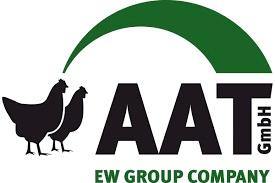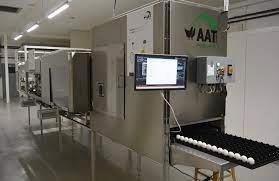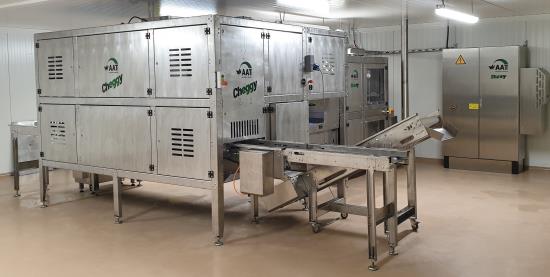 AAT (Agri Advanced Technologies) GmbH, a subsidiary of the EW Group has developed a high-throughput gender determination and stunning system to identify and remove hatching eggs containing male embryos during incubation. The system was developed to confirm to EC Regulation 1099/2009 in collaboration with the German Training and Consultancy Institute that specializes in the welfare, transport and slaughter of poultry.
AAT (Agri Advanced Technologies) GmbH, a subsidiary of the EW Group has developed a high-throughput gender determination and stunning system to identify and remove hatching eggs containing male embryos during incubation. The system was developed to confirm to EC Regulation 1099/2009 in collaboration with the German Training and Consultancy Institute that specializes in the welfare, transport and slaughter of poultry.
The automated gender determination module termed Cheggy can differentiate between fertile eggs containing either male or female embryos at thirteen days of incubation. The principle of the system is based on gender dimorphism of plumage color in brown-feathered laying strains. Female embryos develop brown feathers and can be distinguished from white-feathered males using hyperspectral imaging. Eggs are illuminated from below to allow an imaging system to determine gender using an algorithm to achieve at least 95 percent accuracy. The system will also identify and remove infertile eggs.

The Cheggy module can operate at a rate of up to 20,000 eggs per hour and does not affect hatchability. The system has obvious advantages over unacceptably slow-throughput technology including Raman spectroscopy or assays to detect sex hormones that require penetration of the shell. The only disadvantage with the Cheggy hyperspectral approach is that it is only suitable for brown-feathered strains of hens. Given that the earliest practical age for gender determination with the system is twelve to thirteen days, welfare advocates that originally demanded technology that could distinguish between males and females before four days of incubation will have to accept the scientific reality that pain in embryos is probably perceived only after fourteen days*, extending into the end of the second trimester of embryonic development.
AAT has developed a complementary unit to stun and effectively stop development of male embryos in the shell following gender determination. Eggs are conveyed through the module and a stunning pin penetrates the bottom of the eggshell making contact with embryonic fluids. The top stunning pin then penetrates the shell, and a current is passed through the egg effectively stunning the embryo. The Stunny module incorporates a fixation system that ensures consistent and even penetration of the egg irrespective of size. Operation of the Stunny module is monitored by recording current flow for individual eggs with printouts to document efficacy at a rate consistent with commercial operation.
Given that the majority of egg-producing strains in the E.U. are brown-feathered, the system has gained acceptance and is in commercial use in France and Germany. Adoption in the U.S. may however be limited given that the domestic market is predominately for white-feathered strains for which the hyperspectral differentiation technology would not be applicable.
 In the E.U there may still be resistance to the Cheggy/Stunny combination based on the fact that male embryos are identified and stunned at thirteen days of incubation although this is before the threshold of pain perception. There will also be opposition on philosophical grounds by the extremist opponents of all forms of intensive livestock production that male chicks are subject to discriminatory disposal, although this is considered a non-material and irrelevant objection.
In the E.U there may still be resistance to the Cheggy/Stunny combination based on the fact that male embryos are identified and stunned at thirteen days of incubation although this is before the threshold of pain perception. There will also be opposition on philosophical grounds by the extremist opponents of all forms of intensive livestock production that male chicks are subject to discriminatory disposal, although this is considered a non-material and irrelevant objection.
The Cheggy and Stunny modules are supplied to participating hatcheries on a royalty basis similar to the Embrex™ in ovo vaccination system or the Nova-Tech® robotic beak treatment and vaccination module. According to AAT the royalty fee in the E.U. is the equivalent of $1.13 per pullet chick delivered. This represents approximately 18 percent of the value of a $6.00 pullet reared cage-free to 20 weeks. Alternatively the cost would be 3.8 cents per dozen amortized over 30 dozen eggs per pullet housed over a 60-week laying cycle (420 days) scheduling for depletion at 80 weeks of age. To place the incremental cost in perspective the royalty fee would be equivalent to a simultaneous increase in corn of 50 cents per bushel and an escalation of $40 per ton for soybean meal. Year to date escalation in ingredient prices has added 7 cents per dozen to the cost of production.
Given 95 percent accuracy in gender determination there will be a cost associated with inadvertent destruction of female embryos misidentified by the system. This will require placement of approximately seven percent more hatching eggs to maintain production. Some provision will have to be made for either rearing or humane disposal of males that are hatched.
The hatchery will have to provide adequate space for a retrofit or to increase the area of a new hatchery to accommodate the installation. Conveyors and other mechanical installations, supply of power and services will be required to achieve the projected rate of processing. Additional labor requirements are unknown for U.S. hatcheries.
AAT has invested in research and development to achieve commercial application and will carry the cost of construction, shipping and installation of the system in addition to maintenance, all of which are figured into the royalty fee.
The AAT gender system provides an immediate and practical solution for the challenge of gender determination in brown-feathered strains. The Cheggy and Stunny modules appear to be suitable for retrofitting to existing hatcheries and will operate at an acceptable rate without involving major capital investment by the hatchery. The question is whether sufficient demand exists in the U.S. for gender-sorted pullets, obviating post-hatch disposal of cockerels. Given the cost differential for generic eggs, customers, consumers, and welfare organizations that establish standards, may accept stun-to-kill using carbon dioxide prior to disposal by maceration. This approach is infinitely less expensive than hyperspectral gender determination and is applicable to white-feathered hen strains.
AAT bear the risk that their technology could become obsolete by less expensive technology in a number of years although prospects for non-destructive visualization and spectrometry appear remote. If, and this is a substantial if, that the NRS or alternative genetic modification technology is acceptable to primary breeders and is commercialized the egg industry would have a simpler, more elegant solution applicable to white and brown-feathered strains presumably at a lower cost.
Currently and for the foreseeable future, the AAT gender sorting system for the E.U. is acceptable and beneficial given the prevailing legislative and welfare environment. There are differences in structure relating to supply of pullet chicks compared to the E.U with fewer, larger hatcheries each consigning a wider range of products in the U.S. The egg-industry in the U.S. is conditioned to minimum cost of production and low margins. There is no immediate prospect of passing on additional costs through a welfare premium and no evidence of restrictive legislation or serious demands for an alternative method of disposing of cockerels other than post-hatch hypercapnic (CO2) stun to kill..
* Mellor, T and Diesch, T. (2007) Birth and hatching: Key events in the onset of awareness in the lamb and
chick, New Zealand Veterinary Journal, 55:2, 51-60, DOI: 10.1080/00480169.2007.36742